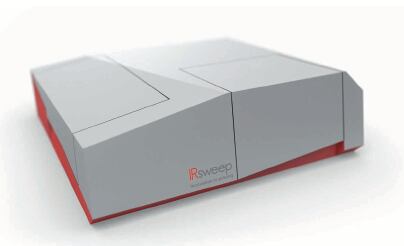The company was founded in 2014 as a spin-off company from ETH Zurich.
It offers infrared spectrometers based on semiconductor quantum cascade laser (QCL) frequency combs in the mid-infrared spectral range (from 2500 cm-1 (4 µm) to 900 cm-1 (12 µm)).
Users get a broad spectral coverage in a single-shot measurement instead of single-frequency operation that demands tuning over the range of interest.
Potential in food & beverage
Markus Geiser, co-founder, said it is exploring different applications to learn where it can help the most.
“We invented a new type of laser and it was shown that this was suitable for fast and sensitive infra-red spectroscopy so we decided to take this to the market and make an instrument out of it. We spent the first two and a half years on technology development, turning these laser devices into a viable instrument with lots of integration work and industrialisation,” he told us at Analytica 2018.
“In the beginning of 2017 we first showed the instrument to the public and since we’ve been looking at different applications in biology and chemistry and industrial applications like food and beverage.
“We are looking to not only sell the instrument but to build partnerships to help people study what they are interested in and they help us improve our proposition and the product.”
The company has already been in contact with a researcher in Austria interested in milk quality.
“The idea would be to quantify the content of different proteins in milk,” said Geiser.
“We have a high measurement speed and high precision, a good signal to noise ratio in a short time. The brightness is an important advantage over existing instruments because you can have more tolerance towards strong absorptions in samples.”
Second-generation instrument
IRsweep launched the second generation of its mid-IR frequency comb spectrometer at Analytica. The benchtop instrument has a width of 60cm and is not as deep as the first version to save space.

The IRisF1 Dual-Comb mid-IR spectrometer features exchangeable sources, time resolution of microseconds and multi-colour output.
It is for applications where high time resolution, brightness or throughput are needed such as analysis and monitoring of fast reactions in biological samples and of chemical composition.
“That is one of the criticisms we got that [the first version of the instrument] is still adapted to a physics lab because you have these deep optical tables and this is not the case for typical laboratories,” said Geiser.
“The second generation will have the possibility to exchange the laser source as depending on the application you will need to decide where you want your laser centred and it allows the user to do the laser exchange himself.”
The user-exchangeable laser module means all the mid-IR range can be addressed with one instrument.
Compared to FTIR
The technology is different from Fourier-Transform Infrared (FTIR) spectroscopy as it uses dual-comb spectroscopy (DCS) that relies on broadband lasers.
IRSweep said today's FTIR spectroscopy instruments are often not fast enough for time-resolved applications and signal-to-noise ratios lag behind laser-based systems.
“For that reason we have higher brightness than traditional lamp-based systems and we can measure much faster,” said Geiser.
“The detection type that we use [dual-comb spectroscopy] was awarded the Nobel Prize in 2005 and the technology was successful for high precision spectroscopy but it hardly made it out of physics labs because it was always very complex, time consuming and expensive to set up.
“We were able to set up quite simple versions of this frequency comb which is required for that and that allowed us to integrate and bring it out of the physics lab and bring it to industry.”
Geiser said it builds to order with the key element being the laser.
“If the customer chooses a laser that we already have, for an application we have done before, then we look to a three to four month delivery time,” he said.
“If you have a specialised application and we do not have the laser supply available then it takes a bit longer for us to qualify the system and the lasers for what the customer needs but we have experience in developing new wavelength ranges with customers for new applications.”
